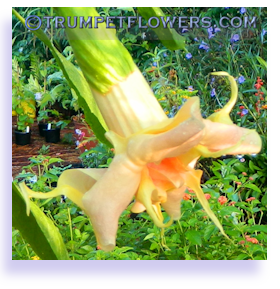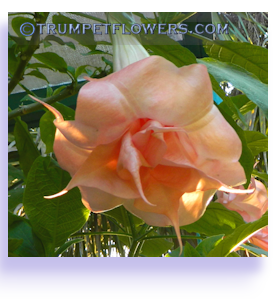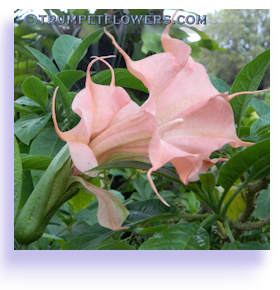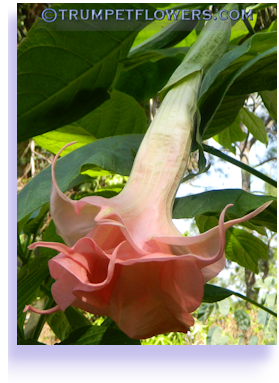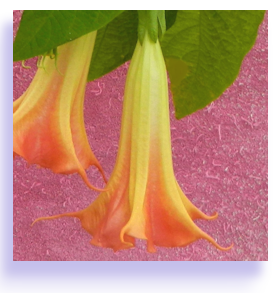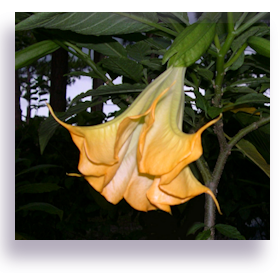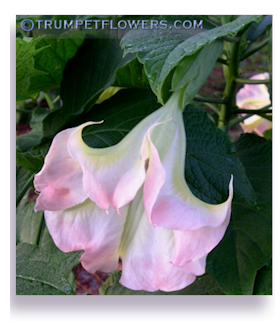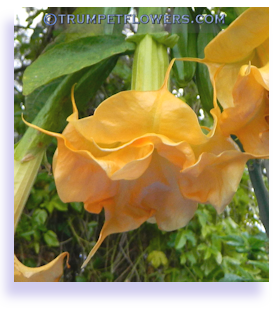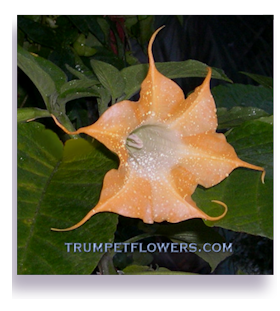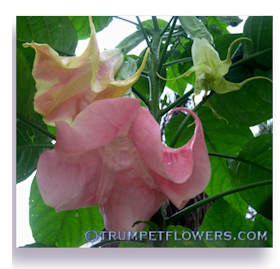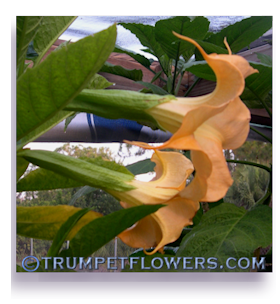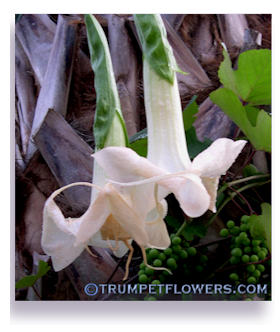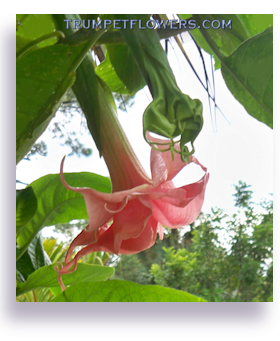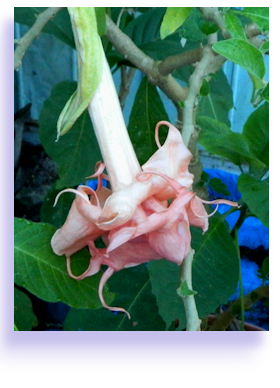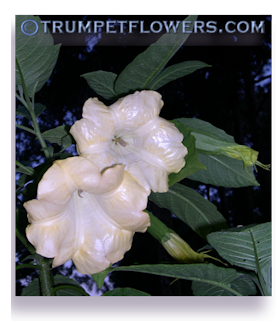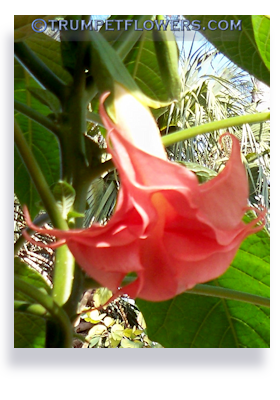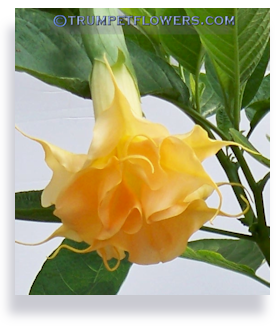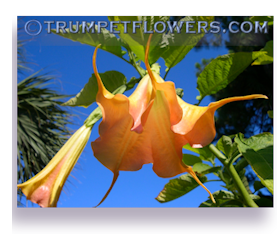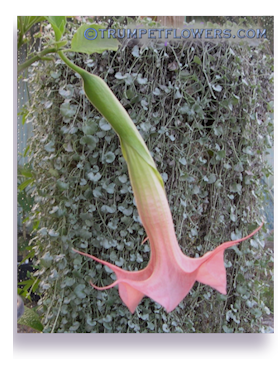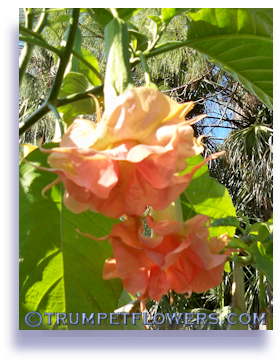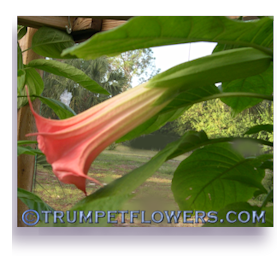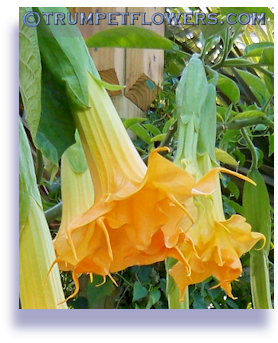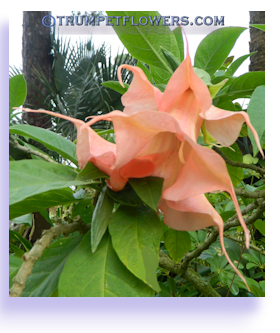Get Brugmansia
Blooming
Get Brugmansia to Bloom
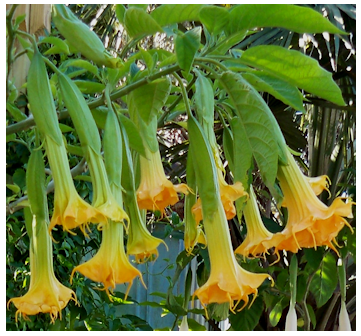 Brugmansia are fantastic small trees to cultivate. Reason number 1 is they grow super fast, and within 3 years are mature enough that the most trees will be well over your head and putting out tons of big, fragrant flowers. And, Angel Trumpets are an easy small tree to grow. But getting them to bloom can be frustrating. To encourage brugmansia to flower, I have put information below as some pointers to get you started. But first, allow me explain some of the mystique of brugmansia that is relevant to why you may not have blooms yet. Under this information, are tips on proper fertilizer, foliar feeding, making monster sized blooms, and much other information to get your brugmansia to bloom for you.
Brugmansia are fantastic small trees to cultivate. Reason number 1 is they grow super fast, and within 3 years are mature enough that the most trees will be well over your head and putting out tons of big, fragrant flowers. And, Angel Trumpets are an easy small tree to grow. But getting them to bloom can be frustrating. To encourage brugmansia to flower, I have put information below as some pointers to get you started. But first, allow me explain some of the mystique of brugmansia that is relevant to why you may not have blooms yet. Under this information, are tips on proper fertilizer, foliar feeding, making monster sized blooms, and much other information to get your brugmansia to bloom for you.Brugmansia is a plant with an unusual habit. It must create a Y shape in the trunk (a fork) before it will bloom. All of your flowers will come above this Y shape in the trunk. The plant will further branch out from there, and at each node, it will create a peduncle containing a covered flower bloom. At first, the bloom-pod (actually a calyx) will point upwards. As the flower begins to grow inside and fill out the calyx, it will begin to turn downwards. That is, on most brugmansia. A few will stand out facing level (horizontally). Cultivar Bernstein comes to mind.
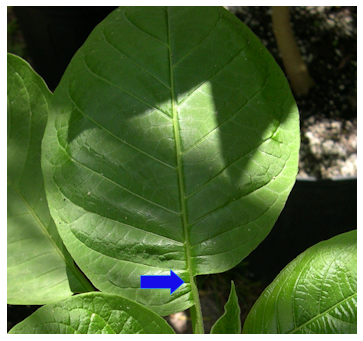 There are some other interesting things about brugmansia. When the plant is getting ready to create it's first Y, the leaf that is before it will be ► sub-equal at the stem. You can be sure the Y will be next. Take a good look at your own plant now that you see the photo. Notice the two different leaf levels? The equal leaves are called vegetative growth, and the plant uses this leaf to feed itself. These are found on the trunk, before the Y. For some unknown reason, the sub-equal leaf brings the promise of branching out, and thus flowers. Of course, these leaves still help feed the plant, they just show to you, the observer; the expectation of flower buds.
There are some other interesting things about brugmansia. When the plant is getting ready to create it's first Y, the leaf that is before it will be ► sub-equal at the stem. You can be sure the Y will be next. Take a good look at your own plant now that you see the photo. Notice the two different leaf levels? The equal leaves are called vegetative growth, and the plant uses this leaf to feed itself. These are found on the trunk, before the Y. For some unknown reason, the sub-equal leaf brings the promise of branching out, and thus flowers. Of course, these leaves still help feed the plant, they just show to you, the observer; the expectation of flower buds.

When brugmansia are cloned, the younger cutting that now becomes the new tree has to mature before making that Y and creating blooms. Depending upon whether the cutting was taken from the trunk, or vegetative growth part of the plant, or if the cutting was from above the fork, or Y, will depend on how fast you get blooms. The Forked Y top cuttings are already growing adult material in the stem cells, so they think they are adults and therefore create another Y sooner, hence flowering sooner. If you have a plant that just keeps growing upwards without forking, you most likely have a trunk cutting and just have to wait for it to create it's first Y.
For more on Brugmansia Y's, and a photo of what some mistake for a Y, click Is this a Y?
Remove Vegetative Growth
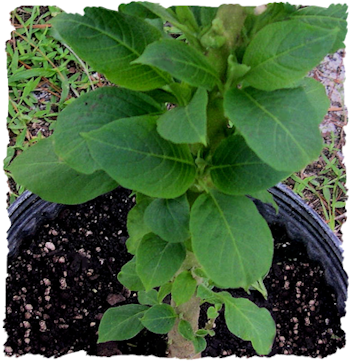 Vegetative growth in brugmansia is described as the main trunk of the plant, before she makes the Y, or Fork.Brugmansia will create small leaves along this main trunk. Remove these leaves below the Y (or upcoming Y) and any shoots that might arise from the base to help the plant use all of it's energy into putting out that Y we mentioned above. I remove shoots, but not leaves, until she Y's. After it Y's, remove the leaves on trunk.
Vegetative growth in brugmansia is described as the main trunk of the plant, before she makes the Y, or Fork.Brugmansia will create small leaves along this main trunk. Remove these leaves below the Y (or upcoming Y) and any shoots that might arise from the base to help the plant use all of it's energy into putting out that Y we mentioned above. I remove shoots, but not leaves, until she Y's. After it Y's, remove the leaves on trunk.
 Allowing time for the brugmansia's root ball to mature is also important. Depending on what climate you live in, this can take anywhere between 3 and 5 years. A well established rootball means more flower flushes. They can and do bloom with smaller root systems, but the best flushes will be after that rootball gains some mass.
Allowing time for the brugmansia's root ball to mature is also important. Depending on what climate you live in, this can take anywhere between 3 and 5 years. A well established rootball means more flower flushes. They can and do bloom with smaller root systems, but the best flushes will be after that rootball gains some mass.
 Because the Angel is young, sometimes the first year of blooming a double flowering cultivar may only appear as a single. It is the second year where it should surely begin to give off the double blooms. The brugmansia is most likely busy putting most of the energy into an established root and leaf system. So if you purchased an angel trumpet that is proported to be a double bloom, and the first year you only see singles, do not fret nor think you were duped. Sometimes they just do that. I have two cultivars that were new to me just last year, and only now are throwing double blooms. Although this is not always the case, do not be surprised if that happens to you. Even a mature, healthy and well fertilized plant can sometimes throw single blooms your way. It is just the nature of this fascinating plant to sometimes be elusive. Insect pests and stress can sometimes play a role in this too, so if your mature plant continues to do this, check for those factors and rebalance their growing environment.
Because the Angel is young, sometimes the first year of blooming a double flowering cultivar may only appear as a single. It is the second year where it should surely begin to give off the double blooms. The brugmansia is most likely busy putting most of the energy into an established root and leaf system. So if you purchased an angel trumpet that is proported to be a double bloom, and the first year you only see singles, do not fret nor think you were duped. Sometimes they just do that. I have two cultivars that were new to me just last year, and only now are throwing double blooms. Although this is not always the case, do not be surprised if that happens to you. Even a mature, healthy and well fertilized plant can sometimes throw single blooms your way. It is just the nature of this fascinating plant to sometimes be elusive. Insect pests and stress can sometimes play a role in this too, so if your mature plant continues to do this, check for those factors and rebalance their growing environment.
Brugmansia blooms get better with time. As the tree matures, you will find that your blooms look better and better. Below photo shows Rosamond, in ground and over 10 feet tall, he's about 5 years old now. (2014) He'd most likely be taller, but he is rooted up in a 22 gallon underground pot with holes in sides. I'm sure it is helping to somewhat restrain him.
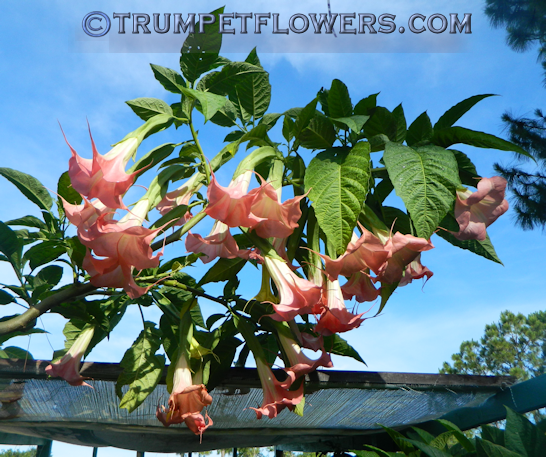
Angel Trumpet Flowering from Seed
If your brugmansia is from seed, and you have treated it well with lots of fertilizer and good soil, regular repotting, it can bloom for you the first year. But do not be dissappointed if it takes more than that. Some brugmansia take 16 to 18 months to flower from a cross, especially those of aurea genetic crosses. Most all other crosses will set flowers within the 18 month window. Other highly experienced Brugmansia Growers report it can take up to 3 years on some crosses to see that first bloom. For more on seeds and seed pods of brugmansia, read Everything you ever wanted to know about Brugmansia Seeds and Seed pods.
Fertilizer for Brugmansia
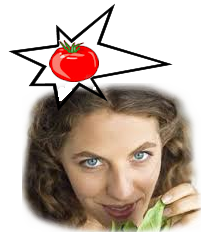
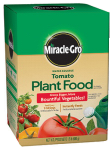 Brugmansia are the hungry, hungry hippos of the Plant Kingdom! Unless you fertilize, you can forget the fantastic, huge flushes you find pictures of on the internet! Just like their close relative, the tomato, they need to eat, and a lot of it. Just rub a young leaf on your brugmansia between your fingers. Now smell it. Smell tomato? Treat it like tomato, and feed it often! Recently Miraclegro has changed their Tomato fertilizer to 'Plant Food.' It does contain macronutrients Iron, Zinc, Manganese, and Copper, besides the NPK, so it's great for the brugmansia.
Brugmansia are the hungry, hungry hippos of the Plant Kingdom! Unless you fertilize, you can forget the fantastic, huge flushes you find pictures of on the internet! Just like their close relative, the tomato, they need to eat, and a lot of it. Just rub a young leaf on your brugmansia between your fingers. Now smell it. Smell tomato? Treat it like tomato, and feed it often! Recently Miraclegro has changed their Tomato fertilizer to 'Plant Food.' It does contain macronutrients Iron, Zinc, Manganese, and Copper, besides the NPK, so it's great for the brugmansia.
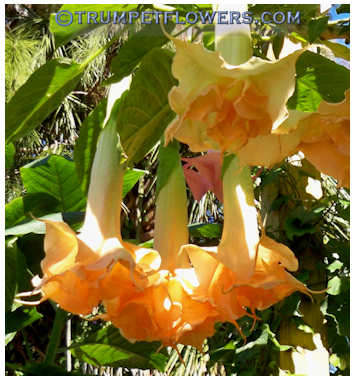 Brugmansia are supposedly not big on Phosphates. That's the middle number in the fertilizer. The three fertilizer numbers are properly called NPK. So choose a low numbered fertilizer when it comes to phosphate. A very good fertilizer ratio for brugmansia is 15-5-10, or 30-10-20.When your brugs are outside, potted, and ready to grow and bloom, feed them full strength liquid fertilizer once to twice a week in amount directed on label. Osmocote Flower and Vegetable is also a micronutrient additive, and can be placed in the pot when you are first potting up the brugmansia. It lasts about 3 months, so every few months lightly rake the surface of the pot and add more according to pot size, and always addwhen repotting to a larger size. Osmocote Flower and Vegetable is readily available at the big box stores and home improvement places.
Brugmansia are supposedly not big on Phosphates. That's the middle number in the fertilizer. The three fertilizer numbers are properly called NPK. So choose a low numbered fertilizer when it comes to phosphate. A very good fertilizer ratio for brugmansia is 15-5-10, or 30-10-20.When your brugs are outside, potted, and ready to grow and bloom, feed them full strength liquid fertilizer once to twice a week in amount directed on label. Osmocote Flower and Vegetable is also a micronutrient additive, and can be placed in the pot when you are first potting up the brugmansia. It lasts about 3 months, so every few months lightly rake the surface of the pot and add more according to pot size, and always addwhen repotting to a larger size. Osmocote Flower and Vegetable is readily available at the big box stores and home improvement places.
It is important to note that adding Osmocote micronutrients to your brugmansia's potting soil is essential in maintaining the angel trumpet's overall health and viability. Fertilizers are not plant foods. Osmocote makes up for what fertilizers lack. A must have for healthy, blooming brugmansia trees.
I did a fertilizer experiment using many different common fertilizers at the end of 2012. It did prove that the MiracleGro tomato fert was the best. If you'd like to read and see my results, go here: Various Plant Fertilizer Experiments. The funny thing about my experiment is that it showed to me, that the phosphate number being as high as the nitrogen number was not concerning my cuttings. Perhaps this pertains to older brugmansia, but so far, mine are seeming to like it. Check it out for yourself.
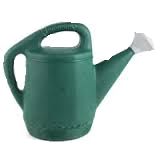 I personally place 1 level tablespoon (the big side of the green spoon that is supplied with the fertilizer) on my brugmansia twice to three times a week, in a large standard watering can. If you overdo the fertilizer, the leaves will yellow more frequently, and that means just weaken the fertilizer a bit and the problem will resolve itself.
I personally place 1 level tablespoon (the big side of the green spoon that is supplied with the fertilizer) on my brugmansia twice to three times a week, in a large standard watering can. If you overdo the fertilizer, the leaves will yellow more frequently, and that means just weaken the fertilizer a bit and the problem will resolve itself.
I also add Time-Release Palm and Citrus fertilizer to the surface of the pots, at recommended amount, every 3 or 4 months. My favorite brand is Rite Green, because they do add some micronutrients to their blend. It is hard to over-fertilize a brugmansia, and they will thrive if you do the same. Just look at my pictures. ☺
Two or three times a month, give the brugmansias a regular shot of the MiracleGro Tomato fertilizer to encourage bloom building. With this combination, you should lose less leaves to yellowing and still get big, healthy blooms on your angel trumpets.
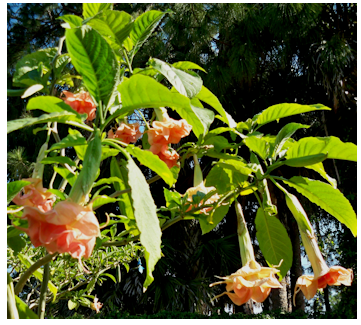 If my plants are not potted, but in the ground, go ahead and use MiracleGro Tomato Plant food.. A couple of times a week, I give them a nice dose, when I know it is not going to rain for several days. Brugmansia sitting with their roots in Florida soils will lose their fertilizer much quicker, so a combination of kelp powder at directed dosage once a month, and MiracleGro twice a week, is fed to the roots of in-ground brugs. Water the plant very well with regular water first, then add the fertilizer water from a watering can prefilled to the proper dosage of fertilizer. I also give them Green Rite Palm & Citrus fertilizer granules in spring, summer and fall, along with the regular fertilizing. That particular fertilizer contains micronutrients. Make sure your plant is not too close to a canal or other water-source, as water-soluble fertilzers might otherwise get into the water table, creating an outgrowth of algae, a huge problem down here. When I see the plants making calyxes (which are going to be your flowers) I up the MiracleGro to 3 times a week until they bloom.
If my plants are not potted, but in the ground, go ahead and use MiracleGro Tomato Plant food.. A couple of times a week, I give them a nice dose, when I know it is not going to rain for several days. Brugmansia sitting with their roots in Florida soils will lose their fertilizer much quicker, so a combination of kelp powder at directed dosage once a month, and MiracleGro twice a week, is fed to the roots of in-ground brugs. Water the plant very well with regular water first, then add the fertilizer water from a watering can prefilled to the proper dosage of fertilizer. I also give them Green Rite Palm & Citrus fertilizer granules in spring, summer and fall, along with the regular fertilizing. That particular fertilizer contains micronutrients. Make sure your plant is not too close to a canal or other water-source, as water-soluble fertilzers might otherwise get into the water table, creating an outgrowth of algae, a huge problem down here. When I see the plants making calyxes (which are going to be your flowers) I up the MiracleGro to 3 times a week until they bloom.
You can always tell when you have used a fertilizer with too high of a nitrogen ratio. Although brugmansia will naturally lose their leaves, and regrow them quickly, if you have an abundance of yellowing leaves falling off, it is due to the high Nitrogen numbers. Cut down on that, and you will have a leafier trumpet flower plant. Add manganese through foliar feeding powdered kelp once a monthfor improvement. Some add epsom salt, but I hate using it. Each brugmansia is different, and the recipe must be exact. Finding that perfect amount can cost you with funny looking leaves for months to come. Take heed. Stick with kelp powder to add nutrients your plants need, and avoid epsom salts. However, I do add a touch of it when making my own brugmansia tea. It is mixed with so many other ingredients and weakened down to the point I feel it does it's supposed job.
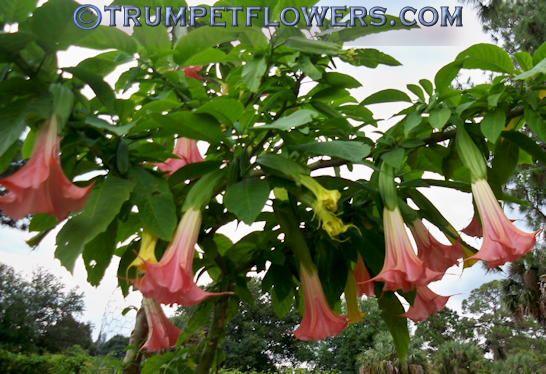
Some people confuse the manganese and magnesium presence in epsom salts. Epsom salts actually contain magnesium sulfate at about a 10 percent ratio. Manganese is better used by plants when used in conjunction with iron. If you are interested in learning more about this and how these two affect your plants, I found an excellent read here: Magnesium and manganese deficiencies in citrus. It affects brugmansia and other plants the same way as citrus, so is highly relevant reading material. And here is a superb read on minerals and nutrients and how they affect the health of your plants. You can even purchase these choice minerals from them: Soil Minerals Information. Finally, here is link to soil amendments that I have on another page. This can help you find the right soil additives to boost your brugmansia blooms even further: DIY Soil Improvements
Alfalfa pellets are fantastic for brugmansias and blooms. If you want a natural way to boost up your brugmansia's ability to create some fabulous flushes, try it. Your local farmstore should carry them by the pound, much cheaper than anywhere else.
You can even add it to the soil mixes you make up yourself. A small handful per gallon of soil mixture is fine. However, when doing this, let the soil mix rest. By that I mean you must make the batch up in advance, and let it sit over one season (2 to 3 months) before using them. The pellets must first break down and become a true part of the soil mix, or compost. This way they do not take any nutrients from the soil mix when finally used on your brugmansia. If you use the soil mix containing the alfalfa pellets before they break down, they actually take nutrients from the bruggies. Proper use of them will create huge, healthy blooms, so start some alfalfa soil mix in advance and let it rest in a large plastic bin (or even throw in your compost bin) beforehand.
You can also make alfalfa tea from composted pellets, just as you would compost tea. It works sort of like a bloom booster fertilizer. See the page on composting to run through the know-how. Here it is: How to make your own compost. And this page will then show you how to make a special compost tea bucket so you can use the alfalfa/compost tea: Make compost tea.
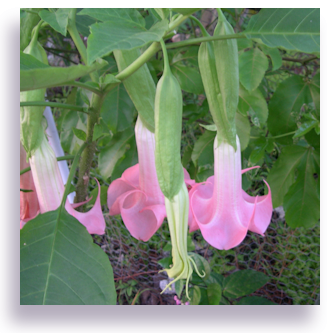 Bud drop on Brugmansia is common in hot temperatures. It is through none of your fault, or lack of derisive work to stop this. Brugmansia are just better performers in cooler to warm temperatures, and although they will bloom in very hot summertime temperatures, they will set stronger, bigger and better buds when the dog days are gone. However, you can counteract, to some extent; bud drop by foliar feeding, making sure to spray the buds until they begin to open, then stop. Foliar feeding must include kelp or seaweed powder if trying to offset bud drop, as the expert brugmansia growers have noticed this is what can help deter it. That is not to say you still won't lose some, but it might help you hang on to more than without the use of foliar feeding.
Bud drop on Brugmansia is common in hot temperatures. It is through none of your fault, or lack of derisive work to stop this. Brugmansia are just better performers in cooler to warm temperatures, and although they will bloom in very hot summertime temperatures, they will set stronger, bigger and better buds when the dog days are gone. However, you can counteract, to some extent; bud drop by foliar feeding, making sure to spray the buds until they begin to open, then stop. Foliar feeding must include kelp or seaweed powder if trying to offset bud drop, as the expert brugmansia growers have noticed this is what can help deter it. That is not to say you still won't lose some, but it might help you hang on to more than without the use of foliar feeding.
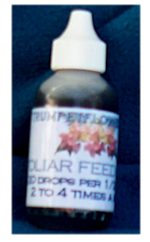
Azomite is truly a wonderful soil additive. It was discovered many years ago in Utah, and is a natural deposit of rock (ground into dust for organic gardening use) containing all the trace elements needed to make your Angel Trumpet thrive, and I mean thrive. I add it to My Foliar Spray Brugmansia tea, with excellent results. Just keyword it in Google to learn more. The reviews on Amazon are overwhelmingly positive. You'll pay a bit more for shipping if you get your first 2 lbs. from them, but it might work out as a test run for you. Keywording it in 44 lb. bags may find it local to your area, or a lot less shipping price from another company.
The 'doos'
Bunny doo is also a great way to help kick-start your brugmansia. Since bunnies are vegetarians, their doo does not 'burn' tender plant roots the way other animals do, even cow or horse manure. So if you have access to bunny droppings, you can directly use it to fertilize your brugmansia.
Worm castings are also a great soil additive. They really enrich the soil with micronutrients that will give you bigger, stronger blooms. Worm castings can be pricey, so if you have the room and time for it, perhaps you can get into your own worm farming with some help here: Do it Yourself Vermiculture. And if you have no aversion to earth worms, try throwing a few into the larger pots your brugmansia are in. They will help aerate the soil with their tunnels, plus add droppings directly to the pots.
Bat guano is also very good for angel trumpets. Used as prescribed on the bag, it can get a brugmansia blooming in no time. Also expensive, if you can't afford this route, just go with the bunny doo or do it yourself vermiculture. Either of these will give similar end results.
Kelp Powders
Kelp powders and other powdered seaweed mixes are excellent for providing organic micronutrients. My personal favorite is called SeaCrop Soluble Kelp Powder, and is available from BGI. If BGI is out, try Maxicrop Kelp powder.Very reasonably priced, and lasts a long time. It is created for foliar feeding, but I also mix it into the water once a month. Do not overuse it, as it can be over-powering. But using it will show an immediate improvement over not using it at all. More blooms, richer colors, and better, stronger overall growth are a few things you will notice. As an example of a plant that had a mineral deficiency, you can check out this page: Mineral and Nutrient deficiencies and how to cure them. Regularly providing kelp powder through a spot of it in the water, or by foliar feeding, can stop you from having to take more drastic measures. A lot goes a long way. Kelp powder contains lots of good things, and is probably one of the most important things in your brugmansia tea mix. Just Look here at what this table says what's naturally occuring within it.
All plants need macro and micronutrients. These can all be found in the kelp powders we talked about above. For more in-depth reading on why these elements are needed by your plants, read this link: New trees.
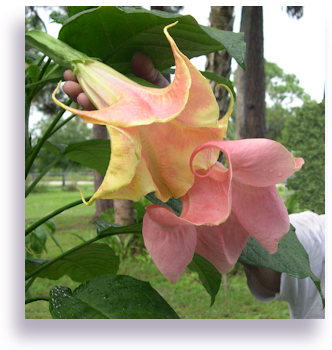 If you like really big blooms, I mean monster sized blooms, you can start by buying or owning a cultivar that already throws big blooms. A few I know of are Pink Dragon, Xena, Santa Rosa, Naughty Nick, Mango Crush, and SuperNova. But on any cultivar, you can get bigger blooms than their usual genetic size by using Superthrive. This stuff contains plant hormones and other vitamins that plants use. In nature, the plant would have to take the vitamins and nutrients from the soil and first convert them before they can use them as sugars to feed themselves. But with the Superthrive, it's already done and the plants do not have to do the conversion. They instantly perk up and the flowers are almost twice as big as when not using it. Superthrive also helps the plant grow much faster, so if you like big leaves and big brugmansia, this stuff will give you what you're looking for. Use it in conjunction with foliar feeding Maxicrop kelp powder mentioned in above paragraph for the best results.
If you like really big blooms, I mean monster sized blooms, you can start by buying or owning a cultivar that already throws big blooms. A few I know of are Pink Dragon, Xena, Santa Rosa, Naughty Nick, Mango Crush, and SuperNova. But on any cultivar, you can get bigger blooms than their usual genetic size by using Superthrive. This stuff contains plant hormones and other vitamins that plants use. In nature, the plant would have to take the vitamins and nutrients from the soil and first convert them before they can use them as sugars to feed themselves. But with the Superthrive, it's already done and the plants do not have to do the conversion. They instantly perk up and the flowers are almost twice as big as when not using it. Superthrive also helps the plant grow much faster, so if you like big leaves and big brugmansia, this stuff will give you what you're looking for. Use it in conjunction with foliar feeding Maxicrop kelp powder mentioned in above paragraph for the best results.
If you want an alternative to Superthrive, make something similar with Brugmansia Tea.
Milorganite as a Bloom Booster
Milorganite is sold in large bags at your local garden center or big box Home Improvement store. This stuff works wonders on brugmansia, and not only gives the leaves a deep, rich green color that all gardener's love, but gives the plant's a boost of iron. If you use this product as prescribed, you will get full flushes on your brugmansia!
If you are getting ready to pot up the plant, and using an 18 inch to 2 feet diameter planter, mix a couple good sized handfuls in with the potting mixture.
If your plants are either potted or in the ground, apply about 2 to 2 1/2 cups around the base of each tree. Do this in early spring, and repeat mid-summer. When adding to the soil surface, try to scratch it in well by using a hand rake or standard rake, being careful of the surface feeder roots of the brugs.
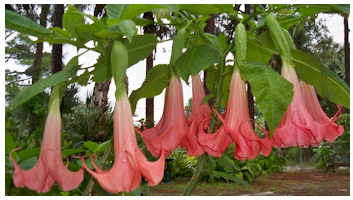 I have found one downside to Milorganite. If you use it in a damp or humid environment, it tends to attract a harmless fungus on the surface. I have tried several tricks to get rid of it, and the best one is to do as I said above, and scratch it lightly into the soil. This mixes it in enough that it tends not to grow.
I have found one downside to Milorganite. If you use it in a damp or humid environment, it tends to attract a harmless fungus on the surface. I have tried several tricks to get rid of it, and the best one is to do as I said above, and scratch it lightly into the soil. This mixes it in enough that it tends not to grow.
I've also experimented with the milorganite by directly mixing it fully into my soil mixing bucket. I then cap it loosley and let it sit a few days. When I reopen the bucket, it has grown the fungus. It's not a slimy type, nor does it smell. It also seems to do no harm at all to the plants I use the soil mix in. It's more of an eyesore than anything. After using said mix when repotting, it dissappears.
For more information on the great uses of Milorganite, go to their website Milorganite.com
All of the above mentioned things will help you get your angel trumpets blooming. But do not become over zealous and create such a cocktail as you actually do them damage. Use them sparingly, and make sure to pay attention to any results. Keep a journal so you know what you used and when you used it. This way you can better see what worked for you. Too much of a good thing can become overkill, and you could potentially burn your brugs.
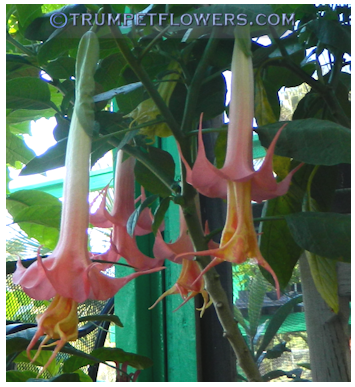 Soils for brugmansia should be light and airy, with extra perlite (more than you find in a MiracleGro premixed bag) with some compost and always Osmocote. Good Soil amendments are the way to go. For more on good, working soil mixes for brugmansia, see the page on soil mixes made by you, Soiless Mixes You Make Yourself. Here's a super easy way to make your soiless mix without breaking your back: Potting Soil Mix using a Cement Mixer. This is how I make mine. Boy, it sure has saved me a lot of work!And if you feel you need to repot your brugmansia, go to this page: Repotting Brugmansia
Soils for brugmansia should be light and airy, with extra perlite (more than you find in a MiracleGro premixed bag) with some compost and always Osmocote. Good Soil amendments are the way to go. For more on good, working soil mixes for brugmansia, see the page on soil mixes made by you, Soiless Mixes You Make Yourself. Here's a super easy way to make your soiless mix without breaking your back: Potting Soil Mix using a Cement Mixer. This is how I make mine. Boy, it sure has saved me a lot of work!And if you feel you need to repot your brugmansia, go to this page: Repotting Brugmansia
(S. Florida) Incidentally, a mature brugmansia will bloom about once a month to every six weeks, in full flushes. This is year round if you keep feeding them. That is, most cultivars. Some are a bit more snooty, and will be stingier with bloom cycles. Weather will also play a role in how often they flush out. Brugmansia like steady, even temperatures above 55° to bloom, and yet when it gets too hot they will also refuse to bloom. After the angel trumpet blooms from the flush are over, it has already begun forming new calyxes, which take the next month to once again bloom. Beautiful!
Brugmansia also flower on new wood much more frequently than old wood. For this reason, pruning the plant back after summer is over and frost might be approacing, can be a good thing. For pruning them see the page Pruning a brugmansia. For overwintering them, see Overwintering brugmansia.
![]() Note: Never pinch off the newest growing tips of your brugmansia!
Note: Never pinch off the newest growing tips of your brugmansia!

Tags: get brugmansia blooming, getting brugmansia to bloom, blooming, bloom booster, blooms, angel trumpet, angels trumpets, trumpet flowers, brugmansia, solanaceae, grow brugmansia, flowers on brugmansia, angel trumpet flowers, milorganite, brugmansia tea, superthrive, alfalfa pellets, brugmansia y, brugmansia fork, vegetative growth, maxicrop seaweed powder, brugmansia bud drop, manganese, magnesium, epsom salts,
This entry was posted on February 14th, 2012 and is filed under Getting Brugmansia to Bloom.
